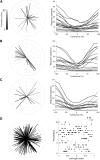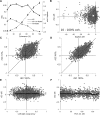Neuronal Correlations in MT and MST Impair Population Decoding of Opposite Directions of Random Dot Motion
- PMID: 30637327
- PMCID: PMC6327941
- DOI: 10.1523/ENEURO.0336-18.2018
Neuronal Correlations in MT and MST Impair Population Decoding of Opposite Directions of Random Dot Motion
Abstract
The study of neuronal responses to random-dot motion patterns has provided some of the most valuable insights into how the activity of neurons is related to perception. In the opposite directions of motion paradigm, the motion signal strength is decreased by manipulating the coherence of random dot patterns to examine how well the activity of single neurons represents the direction of motion. To extend this paradigm to populations of neurons, studies have used modelling based on data from pairs of neurons, but several important questions require further investigation with larger neuronal datasets. We recorded neuronal populations in the middle temporal (MT) and medial superior temporal (MST) areas of anaesthetized marmosets with electrode arrays, while varying the coherence of random dot patterns in two opposite directions of motion (left and right). Using the spike rates of simultaneously recorded neurons, we decoded the direction of motion at each level of coherence with linear classifiers. We found that the presence of correlations had a detrimental effect to decoding performance, but that learning the correlation structure produced better decoding performance compared to decoders that ignored the correlation structure. We also found that reducing motion coherence increased neuronal correlations, but decoders did not need to be optimized for each coherence level. Finally, we showed that decoder weights depend of left-right selectivity at 100% coherence, rather than the preferred direction. These results have implications for understanding how the information encoded by populations of neurons is affected by correlations in spiking activity.
Keywords: electrode arrays; marmoset; motion; population decoding; random dot.
Figures






Similar articles
-
Local and Global Correlations between Neurons in the Middle Temporal Area of Primate Visual Cortex.Cereb Cortex. 2015 Sep;25(9):3182-96. doi: 10.1093/cercor/bhu111. Epub 2014 Jun 5. Cereb Cortex. 2015. PMID: 24904074
-
Sensitivity of neurons in the middle temporal area of marmoset monkeys to random dot motion.J Neurophysiol. 2017 Sep 1;118(3):1567-1580. doi: 10.1152/jn.00065.2017. Epub 2017 Jun 21. J Neurophysiol. 2017. PMID: 28637812 Free PMC article.
-
Response latencies of neurons in visual areas MT and MST of monkeys with striate cortex lesions.Neuropsychologia. 2003;41(13):1738-56. doi: 10.1016/s0028-3932(03)00176-3. Neuropsychologia. 2003. PMID: 14527538
-
A real-time method for generating random-dot motion displays of specified coherence.Spat Vis. 1997;11(1):33-41. doi: 10.1163/156856897x00041. Spat Vis. 1997. PMID: 9304751 Review.
-
Multiplexing in the primate motion pathway.Vision Res. 2012 Jun 1;62:173-80. doi: 10.1016/j.visres.2012.04.007. Vision Res. 2012. PMID: 22811986 Free PMC article. Review.
Cited by
-
A simple linear readout of MT supports motion direction-discrimination performance.J Neurophysiol. 2020 Feb 1;123(2):682-694. doi: 10.1152/jn.00117.2019. Epub 2019 Dec 18. J Neurophysiol. 2020. PMID: 31852399 Free PMC article.
-
Information-Limiting Correlations in Large Neural Populations.J Neurosci. 2020 Feb 19;40(8):1668-1678. doi: 10.1523/JNEUROSCI.2072-19.2019. Epub 2020 Jan 15. J Neurosci. 2020. PMID: 31941667 Free PMC article.
-
Multiunit Frontal Eye Field Activity Codes the Visuomotor Transformation, But Not Gaze Prediction or Retrospective Target Memory, in a Delayed Saccade Task.eNeuro. 2024 Aug 8;11(8):ENEURO.0413-23.2024. doi: 10.1523/ENEURO.0413-23.2024. Print 2024 Aug. eNeuro. 2024. PMID: 39054056 Free PMC article.
-
Spatiotemporal Coding in the Macaque Supplementary Eye Fields: Landmark Influence in the Target-to-Gaze Transformation.eNeuro. 2021 Jan 21;8(1):ENEURO.0446-20.2020. doi: 10.1523/ENEURO.0446-20.2020. Print 2021 Jan-Feb. eNeuro. 2021. PMID: 33318073 Free PMC article.
References
-
- Abbott LF, Dayan P (1999) The effect of correlated variability on the accuracy of a population code. Neural Comput 11:91–101. - PubMed
Publication types
MeSH terms
LinkOut - more resources
Full Text Sources
